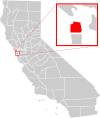Ingleside Terrace | |
|---|---|
| Ingleside Terraces | |
 | |
| Coordinates: 37°43′30″N 122°28′7″W / 37.72500°N 122.46861°W | |
| Founded by | Joseph A. Leonard |
Ingleside Terraces is an affluent residential neighborhood of approximately 750 detached homes built at the former location of the Ingleside Racetrack in the southwestern part of San Francisco, California, United States. It is adjacent to the Balboa Terrace, Ingleside, Merced Heights and Lakeside neighborhoods, and is bordered by Ocean Avenue to the north, Ashton Avenue to the east, Holloway Avenue to the south and Junipero Serra Boulevard to the west. The main local event that occurs is the Annual Sundial Park Picnic, in which the local residents host bicycle, chariot, and wagon racing. There is a large sundial located on Entrada Court, surrounded by the oval-shaped Urbano Drive, which was once a horse race track. Ingleside Terraces is one of nine master-planned residence parks in San Francisco.[1]
YouTube Encyclopedic
-
1/3Views:329 5086 843305
-
Here's the wealthiest neighborhood in San Francisco, California
-
Which San Francisco Neighborhood Should You Move To?
-
Human Rights in Ocean View Merced Heights Ingleside (OMI) San Francisco
Transcription
History
The land used to be part of San Miguel Rancho; and it was one of the last parts of San Francisco to be incorporated. In 1910, Joseph A. Leonard's Urban Realty Improvement Company bought the track and set about turning the land into a residence park. By 1912, Ingleside Terraces had opened, with Urbano Drive paved on the loop of the old racetrack.
Like other suburban developments built in the United States at the time, Ingleside Terraces was explicitly designed to be a segregated whites-only neighborhood, and written into the property deed was a section reading: "That no person of African, Japanese, Chinese, or of any Mongolian descent shall be allowed to purchase, own, lease, or occupy said real property or any part thereof."
In 1922, the Ingleside Presbyterian Church building was completed by Joseph A. Leonard; since November 22, 2016 it is listed as one of the San Francisco Designated Landmarks.[2][3] It started as a church population primarily made of white people of European-descent, and after World War II, the demographic shifted to a primarily African American population.
In 1931, the El Rey Theatre in Ingleside Terraces opened; it was designed by Timothy L. Pflueger.[4][5]
The 1948 Supreme Court case Shelley v. Kraemer declared racial restrictions were illegal and unenforceable in courts, though the restrictions continued to be enforced socially. In 1957, assistant district attorney Cecil F. Poole moved into the neighborhood with his family as the first non-white residents. The following year, on June 5, 1958, other neighborhood residents burned a cross on the front lawn of the Pooles' house.[6] The Cecil F. Poole House is a San Francisco Designated Landmark since 2000.[7]
Ingleside Racetrack

Ingleside Racetrack was opened on November 28, 1895, the result of a dispute between Edward Corrigan and Thomas Williams at Williams’ Bay View Racetrack. The reason for the disagreement is unclear, but Corrigan supposedly vowed to build his own racetrack, bigger, grander, and of higher quality than Williams’.
Eight thousand people came on opening day. Ingleside Racetrack had raised the elegance standard considerably; there were bands, fine dining, wonderful views, a clubhouse; fitting in with the other gambling operations in the area.
The first automobile race in California was held at the track in 1900. Out of the eight vehicles, only the winner reached the finish line; all of the other contestants had either crashed or had engine problems.
By 1905, Thomas Williams had taken over the racing business in the Bay Area, soon adding Ingleside Racetrack to his collection. However, before the track could be reopened, the 1906 earthquake and fires hit. Williams offered the track to the city, free of charge, to serve as a more permanent refugee camp for many homeless San Franciscans. Windows were added to the horse stables, which were cleaned and painted. It also hosted the patients from today's Laguna Honda Hospital as the facility recovered from the earthquake. The track was never re-opened.
References
- ^ "Researching Residence Parks". SF West History. 10 (4). Oct–Dec 2014.
- ^ Cerny, Susan Dinkelspiel (2007). An Architectural Guidebook to San Francisco and the Bay Area. Gibbs Smith. p. 48. ISBN 978-1-58685-432-4.
- ^ Nolte, Carl (3 June 2017). "Ingleside church a portrait of SF's black heritage". San Francisco Chronicle.
- ^ "Redevelopment Plans Move Forward for Historic El Rey Theater In Ingleside". SFist. 2021-08-17. Retrieved 2024-02-29.
- ^ Nolte, Carl (July 2, 2022). "Ocean Avenue is one of San Francisco's unsung streets. Here's why". The San Francisco Chronicle. ISSN 1932-8672. Retrieved 2024-02-29.
- ^ "SAN FRANCISCO PLANNING COMMISSION RESOLUTION NO. 14993" (PDF). May 23, 2000. Retrieved 19 January 2019.
- ^ Cerny, Susan Dinkelspiel (2007). An Architectural Guidebook to San Francisco and the Bay Area. Gibbs Smith. p. 99. ISBN 978-1-58685-432-4.
External links
- Ingleside Terraces history
- 1906 Earthquake
- Ingleside Racetrack
- Then and Now Photographs of Ingleside Terraces
- [1]

